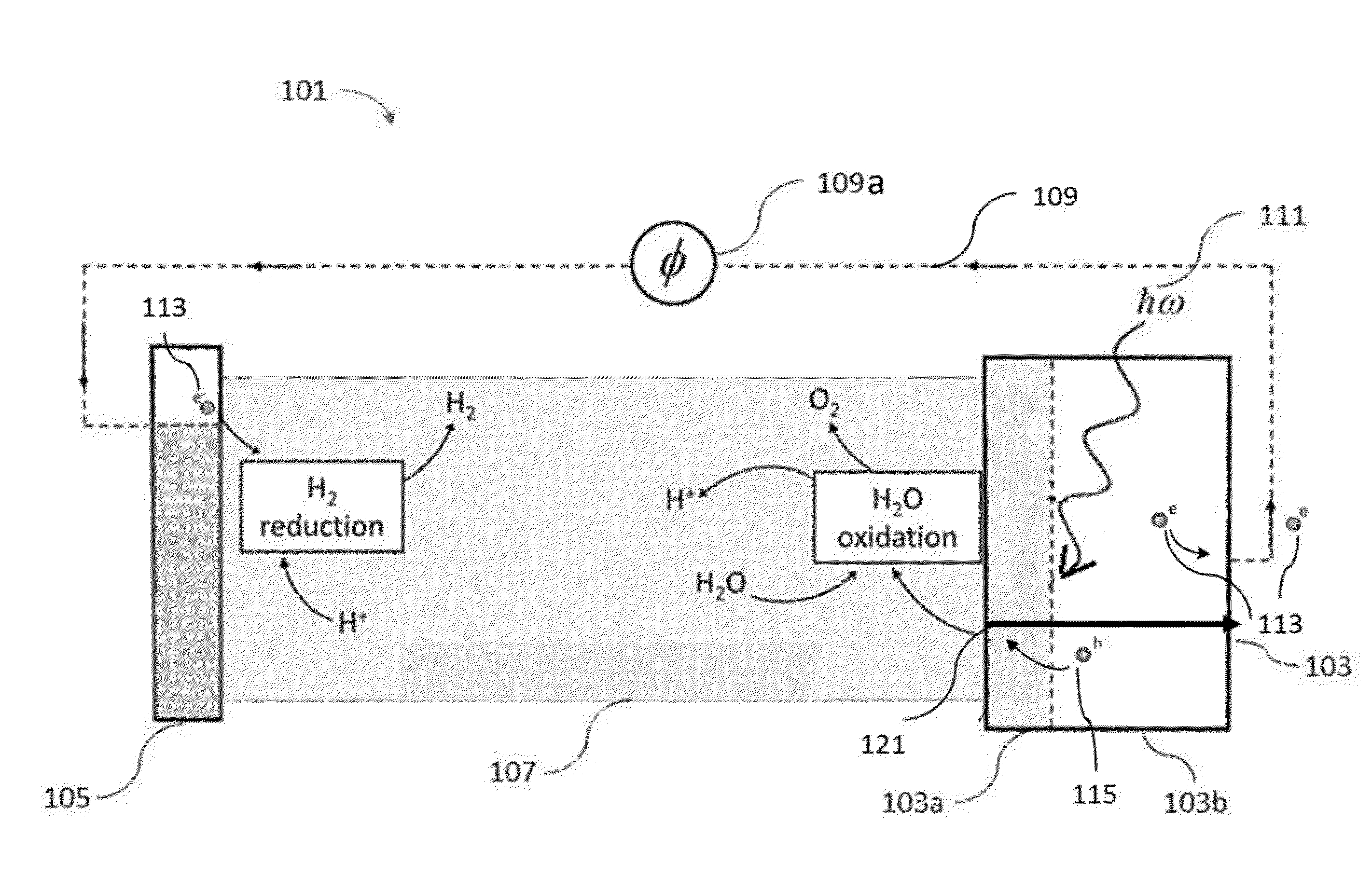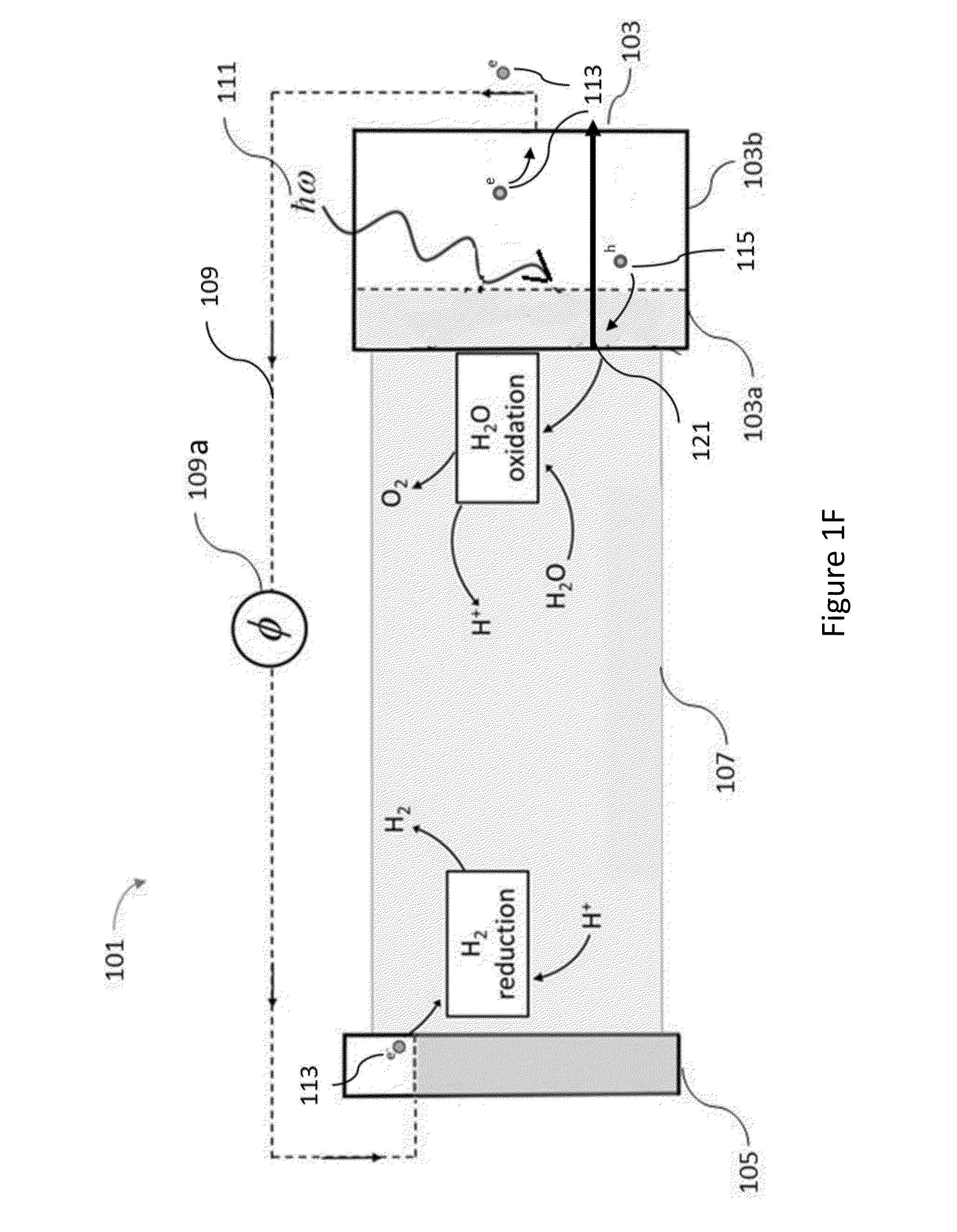Non-uniform doping of photoelectrochemical cell electrodes
a photoelectrochemical cell and electrode technology, applied in the direction of electrolytic capacitors, photovoltaic energy generation, electrolytic capacitors, etc., can solve the problems of non-uniform doping of electrodes, achieve negative effect on chemical reactivity, increase photoactivity and catalytic activity, and enhance the electron conductivity of fe2o3.
- Summary
- Abstract
- Description
- Claims
- Application Information
AI Technical Summary
Benefits of technology
Problems solved by technology
Method used
Image
Examples
example 1
Computational Methods
[0132]The calculations were performed using Vienna Ab-initio Simulation Package (VASP), (Bengone, O.; Blöchl, P.; Alouani, M.; Hugel, J. Implementation of the Projector Augmented Wave Lda and U Method; 2000; Kresse, G.; Hafner, J., Physical Review B 1993, 47, 558-561; Kresse, G.; Furthmüller, J., Computational Materials Science 1996, 6, 15-50).
[0133]Spin polarized DFT+U formalism of Dudarev et al. (Physical Review B 1998, 57, 1505) was chosen since Fe2O3 is a first row transition metal oxide containing highly correlated 3d electrons, whose electron-electron interactions are ill described by regular exchange-correlation (XC) approximations of DFT (Anisimov, V. I.; Aryasetiawan, F.; Lichtenstein, A., Journal of Physics: Condensed Matter 1997, 9, 767; Sandratskii, L.; Uhl, M.; Kübler, J., Band Journal of Physics: Condensed Matter 1996, 8, 983; Rollmann, G.; Rohrbach, A.; Entel, P.; Hafner, J., Physical Review B 2004, 69, 165107).
[0134]A U value of 4.3 [eV] that was...
example 2
Pure Fe2O3 Calculations
[0144]The pure Fe2O3 structure was used for comparison to Pt-doped Fe2O3. Pure Fe2O3 has a 10-atom primitive rhombohedral cell (FIG. 2a). The full long range antiferromagnetic ordering of Fe2O3 was taken into account (Morin, F. J., Physical Review 1950, 78, 819-820; Searle, C. W.; Dean, G. W., Physical Review B 1970, 1, 4337-4342).
[0145]A 7×7×7 gamma-centered k-space grid and a plane wave energy cutoff of 700 [eV] converged the cell energy to a tolerance of <1 [meV / atom]. The cell shape, volume and ionic positions were relaxed. Ionic forces were converged to a minimum with a tolerance of 0.03 [eV / Å].
example 3
Pt-Doped Fe2O3 Calculations
[0146]An 80-atom 2×2×2 supercell was used for Pt-doped Fe2O3 (FIG. 2b). Pt was considered at a substitutional and not an interstitial site, which is a good assumption for a dopant with low misfit (+3: rc=0.785[Å], ri=0.645[Å], Pt+4: rc=0.765[Å], ri=0.625[Å], Pt+2: rc=0.94[Å], ri=0.8[Å]). Pt atoms were set to replace Fe atoms with the relations 1:32 Pt:Fe, corresponding to 1.25% at Pt-doping. This concentration agrees with evidence of high miscibility of Pt in Fe2O3 based on X-ray measurements (Hu, Y.-S.; Kleiman-Shwarsctein, A.; Forman, A. J.; Hazen, D.; Park, J.-N.; McFarland, E. W., Chemistry of Materials 2008, 20, 3803-3805; Mao, A.; Park, N.-G.; Han, G. Y.; Park, J. H., Nanotechnology 2011, 22, 175703; Hsu, Y.-P.; Lee, S.-W.; Chang, J.-K.; Tseng, C.-J.; Lee, K.-R.; Wang, C.-H., Int. J. Electrochem. Sci 2013, 8, 11615-11623; Rahman, G.; Joo, O.-S Materials Chemistry and Physics 2013, 140, 316-322).
[0147]This specific concentration was chosen also to be ...
PUM
| Property | Measurement | Unit |
|---|---|---|
| energy gap | aaaaa | aaaaa |
| total energy | aaaaa | aaaaa |
| total energy | aaaaa | aaaaa |
Abstract
Description
Claims
Application Information
 Login to View More
Login to View More - R&D
- Intellectual Property
- Life Sciences
- Materials
- Tech Scout
- Unparalleled Data Quality
- Higher Quality Content
- 60% Fewer Hallucinations
Browse by: Latest US Patents, China's latest patents, Technical Efficacy Thesaurus, Application Domain, Technology Topic, Popular Technical Reports.
© 2025 PatSnap. All rights reserved.Legal|Privacy policy|Modern Slavery Act Transparency Statement|Sitemap|About US| Contact US: help@patsnap.com



